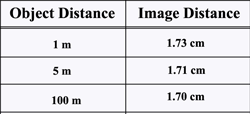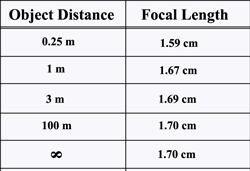Image distances of an object at varying distances
from the eye using a fixed focal length of 1.7cm


A small area of the retina, known as the fovea centralis, with a diameter of approximately 0.25mm contains the greatest concentration of rods and cones, making it the optimal location for the formation of an image. The eye rotates in its socket in order for images to be focused at this location. The distance from the cornea to this small area is approximately 1.7cm, so light entering the cornea must produce an image with a fixed image distance of 1.7cm. To accommodate this, the eye must be able to alter its focal length in order to focus images of objects, either nearby or far away, on the retinal surface. This is known as accommodation. The following tables illustrate the importance of this process. The calculations were made using the lens equation.
Table 1
Image distances of an object at varying distances
from the eye using
a fixed focal length of 1.7cm

Table 2
Dependence of focal length on varying object
distances with the image distance fixed
at 1.7cm

Objects located at varying distances from a lens system with a fixed focal length produce images which are at varying distances from the lens (Table1). However, the eye must always produce images on the retina, which is always a fixed distance from the cornea. In order to focus images with a fixed image distance the eye must accommodate, and alter its focal length (Table2).
Nearby objects are focused at further distances than far away objects. The eye accommodates for this by having the ciliary muscles contract and squeeze the lens into a more convex shape, increasing the curvature of the lens. This causes more refraction resulting in a shorter focal length and an image that is brought back closer to the cornea and upon the retina. (Figure 1)
Far away objects are focused at a closer distance than nearby objects. The ciliary muscles therefore relax to reduce the convexity of the lens, decreasing the curvature and decreasing the refraction so that the focal length is longer and images are pushed away from the cornea and onto the retina. (Figure 3)
Pictures drawn relative to Figure 2.